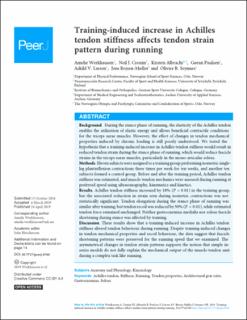| dc.contributor.author | Werkhausen, Amelie | |
| dc.contributor.author | Cronin, Neil J. | |
| dc.contributor.author | Albracht, Kirsten | |
| dc.contributor.author | Paulsen, Gøran | |
| dc.contributor.author | Larsen, Askild V. | |
| dc.contributor.author | Bojsen-Møller, Jens | |
| dc.contributor.author | Seynnes, Olivier R. | |
| dc.date.accessioned | 2020-05-05T09:35:37Z | |
| dc.date.available | 2020-05-05T09:35:37Z | |
| dc.date.created | 2019-10-18T08:14:05Z | |
| dc.date.issued | 2019 | |
| dc.identifier.citation | PeerJ. 2019, 2019 7, e6764. | en_US |
| dc.identifier.issn | 2167-8359 | |
| dc.identifier.uri | https://hdl.handle.net/11250/2653304 | |
| dc.description | Distributed under Creative Commons CC-BY 4.0. | en_US |
| dc.description.abstract | Background: During the stance phase of running, the elasticity of the Achilles tendon enables the utilisation of elastic energy and allows beneficial contractile conditions for the triceps surae muscles. However, the effect of changes in tendon mechanical properties induced by chronic loading is still poorly understood. We tested the hypothesis that a training-induced increase in Achilles tendon stiffness would result in reduced tendon strain during the stance phase of running, which would reduce fascicle strains in the triceps surae muscles, particularly in the mono-articular soleus. Methods: Eleven subjects were assigned to a training group performing isometric single-leg plantarflexion contractions three times per week for ten weeks, and another ten subjects formed a control group. Before and after the training period, Achilles tendon stiffness was estimated, and muscle-tendon mechanics were assessed during running at preferred speed using ultrasonography, kinematics and kinetics. Results: Achilles tendon stiffness increased by 18% (P < 0.01) in the training group, but the associated reduction in strain seen during isometric contractions was not statistically significant. Tendon elongation during the stance phase of running was similar after training, but tendon recoil was reduced by 30% (P < 0.01), while estimated tendon force remained unchanged. Neither gastrocnemius medialis nor soleus fascicle shortening during stance was affected by training. Discussion: These results show that a training-induced increase in Achilles tendon stiffness altered tendon behaviour during running. Despite training-induced changes in tendon mechanical properties and recoil behaviour, the data suggest that fascicle shortening patterns were preserved for the running speed that we examined. The asymmetrical changes in tendon strain patterns supports the notion that simple in-series models do not fully explain the mechanical output of the muscle-tendon unit during a complex task like running. | en_US |
| dc.language.iso | eng | en_US |
| dc.subject | achilles tendon | en_US |
| dc.subject | stiffness | en_US |
| dc.subject | running | en_US |
| dc.subject | tendon properties | en_US |
| dc.subject | architectural gear ratio | en_US |
| dc.subject | gastrocnemius | en_US |
| dc.subject | soleus | en_US |
| dc.title | Training-induced increase in Achilles tendon stiffness affects tendon strain pattern during running | en_US |
| dc.type | Peer reviewed | en_US |
| dc.type | Journal article | en_US |
| dc.description.version | publishedVersion | en_US |
| dc.rights.holder | © 2019 Werkhausen et al. | en_US |
| dc.source.pagenumber | 18 | en_US |
| dc.source.volume | 2019 | en_US |
| dc.source.journal | PeerJ | en_US |
| dc.source.issue | 4 | en_US |
| dc.identifier.doi | 10.7717/peerj.6764 | |
| dc.identifier.cristin | 1738221 | |
| dc.description.localcode | Seksjon for fysisk prestasjonsevne / Department of Physical Performance | en_US |
| cristin.unitcode | 150,31,0,0 | |
| cristin.unitname | Seksjon for fysisk prestasjonsevne | |
| cristin.ispublished | true | |
| cristin.fulltext | original | |
| cristin.qualitycode | 1 | |
